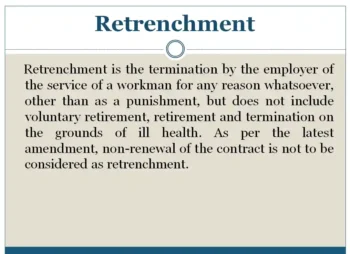Table of Contents:
- Retrenchment Meaning
- What is Retrenchment?
- Reasons for Retrenchment
- Problems of Retrenchment
Retrenchment Meaning
We can define retrenchment as the termination of service resulting from surplus labour.
According to the Industrial Disputes Act, “Retrenchment is the termination by the employer of the service of a workman for any reason whatsoever, other than as a punishment, but does not include voluntary retirement, retirement and termination on the grounds of ill health”.
According to the most recent amendment, we should not classify non-renewal of the contract as retrenchment. Thus, it’s safe to say that every retrenchment is a form of service termination, but not all service terminations qualify as retrenchment.
Retrenchment is different from dismissal. Because of one’s fault, an employee is dismissed but on the other hand, retrenchment is forced on both the employees and the employer. In retrenchment, the termination of services of many employees takes place but in dismissal generally, the termination of service of only one or two employees takes place.
What is Retrenchment?
Retrenchment refers to employee reduction within an organisation. Companies sometimes are forced to downsize their number of employees during financial difficulties or restructuring. Therefore, they use this method to terminate their employees, it is generally done to cut down expenses, particularly payroll.
Reasons for Retrenchment
Reasons for retrenchment are as follows:
1) Poor Performance: When an organization, due to its poor performance, is going through a phase of loss in terms of profits and is not in a condition to sustain its position in the market, then it needs to close down such business units which are in a continuous state of low performance.
2) Threat to Survival: Unforeseen issues in the product market have placed the firm’s survival in jeopardy. There may be pressure on the management from the shareholders and employees to improve the performance by all means even if it requires cutting down its operations.
3) Re-Deployment of Resources: When higher returns can be achieved by some alternate employment opportunities, then there may be a closing down of some existing business units or segments so that their resources can be put to better use for increasing profits and advancements in business.
4) Lack of Resources: To utilise big financial resources to create and maintain a stable position in the market.
5) To Attain Improved Management Efficiency: To simplify the range of activities of the enterprise it may be necessary to reduce some of the present operations to ensure working efficiency at a higher level.
Problems of Retrenchment
Various problems related to retrenchment are as follows:
1) Due to retrenchment, unemployment increases thereby forming the way for crimes in society through activities like robbery, kidnapping, stealing, etc., increases.
2) The work output quality is impacted since the remaining employees are overloaded with work and experienced persons are replaced with new and fresh talents.
3) Retrenchment is not a good option to fight against corruption as it is done fairly thereby removing innocent people and leaving the corrupt ones on the job.
4) Retrenchment harms the self-respect of the workers as investment and gains are given more importance than the workers of the firm.
5) Those persons who have the authority to retrench people, sometimes unfairly retrench them due to their problems and disputes. In schools, it’s a common occurrence for head teachers to retrench teachers on the payroll for personal issues.
6) Many times, retrenched employees get so stressed that they indulge in the bad habits of drug addiction and alcoholism. Such actions lead to the conversion of productive members of society into unproductive ones.
7) Retrenched people are not able to contribute to society as before, i.e., when they were employed. Therefore, they are not given that much respect in society and this results in a drastic change in their social life.
8) Retrenchment results in unemployment, due to which the retrenched worker is not able to fulfil his family’s basic needs like bread, garments, etc. This leads to the emergence of domestic problems such as divorce which disturbs the family and social life of the worker.
Related Articles:
- nature of marketing
- difference between questionnaire and schedule
- features of marginal costing
- placement in hrm
- limitations of marginal costing
- nature of leadership
- difference between advertising and personal selling

You May Also Like :-
Methods of Management Development
Workers Participation in Management
Features of Management Development
Human Resource Development Mechanisms
Process of Human Resource Planning
360 Degree Performance Appraisal
Limitations of Human Resource Planning
Difference between Personnel Management and HRM
